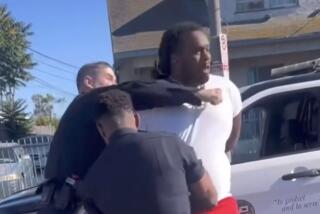Newton: For LAPD, a question of force
Back in the early 1990s, when the Los Angeles Police Department was the source of much fear and brutality, about 1% of its arrests involved the use of some force, from a firm grip to a gunshot. Over the last two years, during a period when the LAPD has been justifiably lauded as a restrained and professional agency, about 1% of arrests involved the use of force.
That remarkable constancy is true despite wide fluctuations in the number of people taken into custody — the department arrested almost 300,000 people in 1990, twice as many as last year — and reflects two aspects of the interaction between police and the public: Most officers do their jobs with good intentions, and most suspects know better than to resist.
Nevertheless, while there are times when force is necessary, there are also times when it is misused, and with grave consequences. Brutality violates the rights of its victims and undermines confidence in the department. So it is with concern, if not quite alarm, that LAPD officials have grappled with a recent spate of allegations of unnecessary force, each of them caught on videotape. The reaction, so far, is encouraging.
The three recent incidents involve different circumstances. In one, a white woman in handcuffs was thrown to the pavement after a traffic stop in the San Fernando Valley; in another, a young black man on a skateboard was struck in the head in Venice; and in the third, an officer kicked a black woman in the groin while putting her in the back of a police car in the department’s Southeast Division. That woman later died in custody, though sources told me that preliminary investigation suggests that the force used against her did not cause her death. The differences among the cases argue against a pattern, but Police Commission member Richard E. Drooyan noted that “each incident is disturbing.”
Police Chief Charlie Beck agreed, both about the seriousness of the cases and their apparent lack of connection. There is no evidence of a sudden increase in the use of force. Indeed, in July and August — two notoriously busy months for the department — the LAPD recorded only one shooting. “That’s incredibly low for us,” the chief said.
Not everyone’s convinced, however. City Councilman Bernard C. Parks, a former chief of police, sees the recent incidents as the product of a long slide away from solid discipline. Parks contends that officers today dress more sloppily and bend other rules: activating their car lights to run red lights, being discourteous to residents, getting into more traffic accidents. His office, he said, gets plenty of complaints.
And those minor violations encourage laxity on more serious issues. “You have to make them understand that there are consequences,” he said of police officers. “Otherwise, it’s the big wink.”
Beck understands that theory of discipline, but he doesn’t buy it here. He’s reacting forcefully to the recent incidents, especially the one involving the woman in handcuffs. In that case, a security camera captured officers from LAPD’s Foothill Division twice throwing Michelle Jordan to the ground, face first, once after she had been handcuffed. The incident appears to end with the officers exchanging a fist bump, though it’s also possible they’re exchanging car keys.
“I’m extremely concerned about that one,” Beck said of the Foothill arrest. He should be. The woman had been pulled over for allegedly talking on a cellphone. There may be mitigating circumstances, but it’s hard to imagine what would justify tossing a handcuffed woman to the pavement. Just as disturbingly, the captain in charge of Foothill Division did not see anything in the videotape that warranted taking the officers off duty or notifying his supervisors. Beck summarily demoted him. I guarantee that no LAPD captain missed the significance of that.
Andrea Ordin, president of the Police Commission, acknowledged that each of the three arrests had raised concerns, and she stressed that any death in police custody requires investigation and introspection. But she too has been gratified by the department’s response. The commission’s inspector general is monitoring the department’s investigations, ensuring that a source independent of the LAPD itself is scrutinizing evidence.
Perhaps most notable has been the response from the rank and file. I checked in last week with several police officers I’ve long trusted; none complained of colleagues being railroaded or media prejudging evidence. Capt. Phil Tingirides of Southeast Division said that most of his officers are being level-headed and patient. Even the officer who writes commentary under the pseudonym “Jack Dunphy” and regularly champions the cop on the beat wrote that “no reasonable cop” was likely to see the treatment of Jordan as justified.
Force will always be a part of policing, and it will often be ugly. But the handling of these cases shows that the rights of accused officers can coexist with the maintenance of public trust. That is a triumph of police reform.
Jim Newton’s column appears Mondays. His latest book is “Eisenhower: The White House Years.” Reach him at jim.newton@latimes.com or follow him on Twitter: @newton_jim.
More to Read
A cure for the common opinion
Get thought-provoking perspectives with our weekly newsletter.
You may occasionally receive promotional content from the Los Angeles Times.











